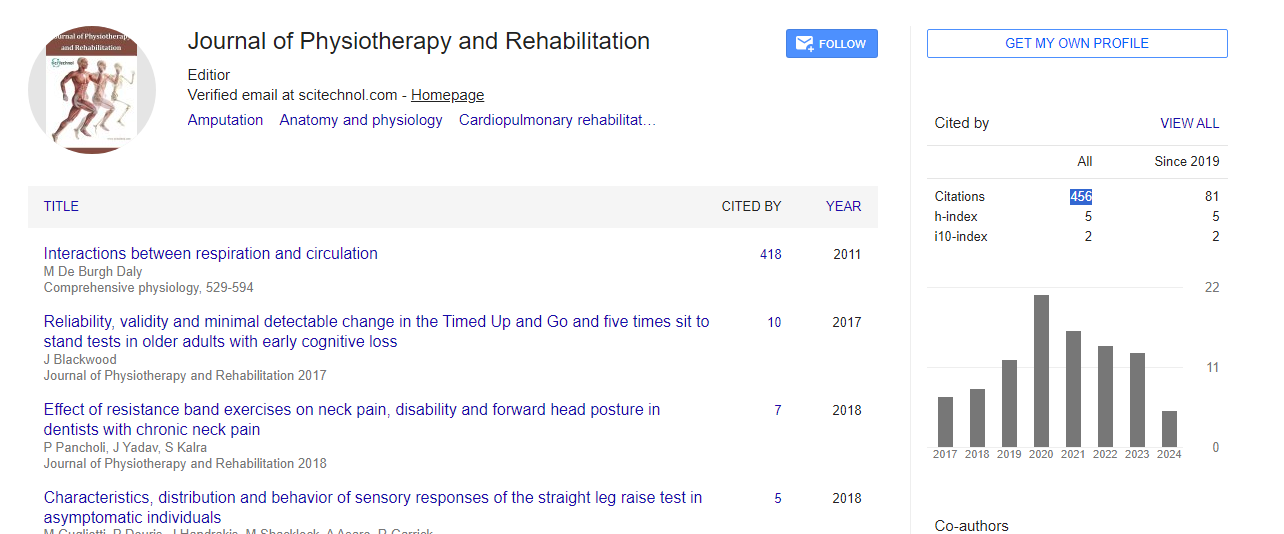Opinion Article, J Physiother Rehabi Vol: 7 Issue: 1
Enhancing Electromyography to Measure Muscle Electrical Activity
Zhiwei Dandan*
Department of Neurology, Sixth Medical Center of Chinese, PLA General Hospital, Beijing, China
*Corresponding Author: Zhiwei Dandan
Department of Neurology, Sixth Medical Center of Chinese
PLA General Hospital, Beijing, China
E-mail: ZhiwDan@hotmail.com
Received date: 03 February, 2023, Manuscript No. JPTR-23-95995;
Editor assigned date: 07 February, 2023, PreQC No. JPTR-23-95995 (PQ);
Reviewed date: 21 February, 2023, QC No. JPTR-23-95995;
Revised date: 28 February, 2023, Manuscript No. JPTR-23-95995 (R);
Published date: 07 March, 2023, DOI: 10.4172/JPTR.1000121
Citation: Dandan Z (2023) Enhancing Electromyography to Measure Muscle Electrical Activity. J Physiother Rehabi 7:1.
Description
Electromyography (EMG) is a widely used technique in the field of neuromuscular research, sports science, clinical practice and rehabilitation. It involves the measurement of the electrical activity of muscles to understand their function, activity patterns and changes in response to various stimuli. EMG has proven to be a valuable tool in assessing muscle health, diagnosing muscle disorders, monitoring muscle performance and guiding rehabilitation strategies. Over the years, significant advancements have been made to enhance the accuracy, precision and versatility of EMG for measuring muscle electrical activity.
High-density EMG
High-density EMG is an advanced technique that involves the use of multiple electrodes to measure muscle activity from a larger muscle area. This allows for a more detailed and comprehensive assessment of muscle functions, including the ability to detect subtle changes in muscle activation patterns. High-density EMG provides a higher spatial resolution, allowing for precise localization of muscle activity and can provide insights into the coordination and synchronization of multiple muscles during complex movements. This technique is particularly valuable in sports science, where it can help identify muscle imbalances, assess muscle activation during specific tasks and optimize training programs.
Multi-channel EMG
Traditional EMG typically uses a single electrode to measure the electrical activity of a muscle. However, advancements in EMG technology have led to the development of multi-channel EMG systems, which allow for the simultaneous measurement of muscle activity from multiple muscles or muscle regions. This enables a more comprehensive assessment of muscle function, as it provides information on the interaction and coordination of different muscles during movements. Multi-channel EMG can be used to study muscle synergies, identify compensatory strategies and assess muscle activation patterns in individuals with neuromuscular disorders.
Wireless EMG
Wireless EMG is a recent innovation that eliminates the need for cumbersome wires and cables, providing greater freedom of movement during EMG measurements. Wireless EMG systems use small, lightweight and wearable sensors that can be attached to the skin or embedded into garments. These sensors transmit the EMG signals wirelessly to a receiver, which can be connected to a computer or a mobile device for real-time data analysis. Wireless EMG is particularly useful in sports science and rehabilitation settings, where it allows for more natural and unrestricted movements during EMG measurements, making it possible to study muscle activity in real-life scenarios.
Real-time EMG feedback
Real-time EMG feedback is a technique that involves providing immediate visual or auditory feedback to the individual being assessed based on their muscle activity measured by EMG. This can help individuals optimize their muscle activation patterns and learn to control their muscles more effectively. Real-time EMG feedback has been used in various applications, including sports performance training, motor rehabilitation and biofeedback training for muscle relaxation or stress reduction. By providing instantaneous feedback, real-time EMG can help individuals improve their muscle activation strategies and achieve better motor control.
Advanced signal processing techniques
Signal processing plays a vital role in enhancing EMG measurements. Advanced signal processing techniques, such as wavelet analysis, time-frequency analysis and machine learning algorithms, are being increasingly employed to extract meaningful information from EMG signals. These techniques can help reduce noise, enhance signal quality and provide insights into the temporal and spectral characteristics of muscle activity. Advanced signal processing can also aid in the detection of muscle fatigue, muscle imbalances and abnormal muscle activity patterns.
Conclusion
The field of electromyography continues to evolve, with ongoing innovations and advancements aimed at enhancing the measurement of muscle electrical activity. High-density EMG, multi-channel EMG, wireless EMG, real-time EMG feedback and advanced signal processing techniques are some of the key areas where enhancements are being made to improve the accuracy, precision and versatility of EMG measurements.
 Spanish
Spanish  Chinese
Chinese  Russian
Russian  German
German  French
French  Japanese
Japanese  Portuguese
Portuguese  Hindi
Hindi 